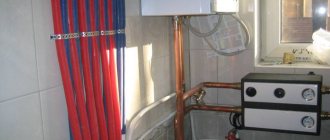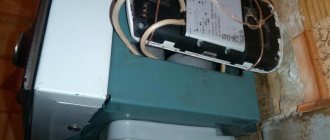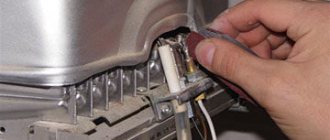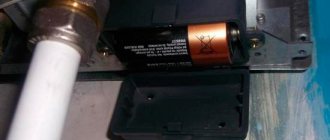Manufacturers
| Manufacturer | Characteristic |
| Vektor JSD 20-W (Russia) | Power - 20 kW. Water consumption when heating 25 °C - 10 l/min. Weight - 10.5 kg. Dimensions (H*W*D) - 580*330*208 mm. Automatic independent electric ignition, powered by batteries. To start, just open the mixer tap. Operates at water pressure from 0.2 to 7.5 atm. Multi-level security system. The automatic protection and safety system turns off the water heater when: - there is no sufficient draft in the chimney; — the flame on the burner goes out; - reducing water flow; - overheating of the heat exchanger. The presence of a digital display that displays the temperature of hot water at the outlet of the water heater. The presence of a “Winter-Summer” mode, which allows you to save gas up to 40% in the warm season. Instability of operation when water pressure changes, auto-ignition failures and heat exchanger leaks due to thin walls. The problem is likely to occur after a year of operation. Low price - about 4,500-4,800 rubles. |
| Neva 4510-M (Russia) | Affordable price and excellent functionality. Work on natural and liquefied gas. Power - 17.9 kW. Productivity - 10 l/min. Possibility of connecting several points of consumption. Bottom gas supply. Quiet operation. The presence of a thermometer and electric ignition on batteries. Works at a water pressure of 0.1 atm. There are problems with the quality of materials used and reliability. |
| Bosch WR 10-2P (Germany) | Power - 17.4 kW. Productivity - 10 l/min. Heating water up to 60 °C. Convenient mechanical rotary switches for temperature adjustment. Two versions of the dispenser are available - P23 for natural gas and P31 for liquefied gas from a cylinder. Work at pressure from 0.1 to 12 atm. The combustion chamber is open type, requiring the installation of an air vent. Easy to operate and install, small dimensions, quiet operation. Installation is vertical, on the wall. Bottom gas supply. Presence of piezo ignition. Thermometer for monitoring water temperature. The model is sensitive to water quality. Relatively high price. |
| Electrolux GWH 265 ERN Nano Plus (Sweden) | Power - 20 kW. Capacity is 10 l/min, which allows you to shower comfortably. Average cost of the model. Work at water pressure from 0.15 to 10 atm. Convenient controls. Installation - vertical, on the wall. Communications connections are from below. Availability of electric ignition. The presence of a “gas control” function that prevents any leakage of flammable substances. Fine temperature regulation and high sensitivity to pressure. |
As a result, the operation of an instantaneous water heater using liquefied gas will allow you to autonomously supply your house or cottage with hot water.
Advantages of a gas water heater.
- The environmental friendliness of the equipment allows us to reduce the emission of carbon monoxide into the chimney to a value much lower than the permissible value - 0.005 at any gas pressure. The flame height is adjusted automatically in proportion to the water pressure.
- The burner is hydraulic, the gas supply is regulated depending on the water pressure.
- The increased diameter of the heat exchanger pipes prevents scale formation.
- 88 - efficiency of the heat exchanger that transfers heat from the combustion chamber.
- Available in all specialized retail outlets at an affordable price.
Connecting equipment to the cylinder
Before you start connecting the equipment yourself, make sure that the model is really suitable.
Other brands of acceptable equipment: , (almost all the latest models). The instructions for the Bosch speakers indicate that a 50-liter cylinder will be enough for 10 hours of stable operation at a power of 25 kW. A conversion kit for Bosch speakers can be purchased from an authorized service center.
If it is necessary to carry out work on reconfiguring equipment, replacing collector nozzles and assessing the tightness of joints, they must be done strictly according to the rules. The nozzles must be smaller in diameter: as in gas stoves, the pressure produced by liquefied gas reducers is 2–3 times higher than when natural gas is supplied through pipes. At the same time, the calorific value of liquid fuel is 1.5 times greater than that of natural gas.
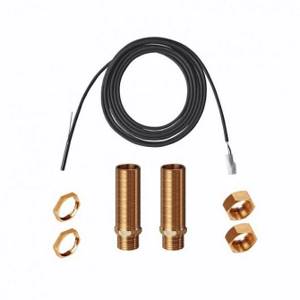
The equipment must be marked with a refurbishment date - day, month and year. The type of gas suitable for use is also indicated.
The connection diagram of the cylinder to the main valve requires it to have a reducer with pressure stabilization of 300 mm of water. Art. and a minimum steam phase productivity of one cubic meter per hour.
Parameters of the hose connecting gas equipment to the fuel tank:
- 250 cm - minimum length;
- 1.2 cm is the least permissible inner diameter of the tube.
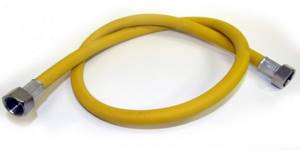
Please note that on online forums there is information of the following nature: if you reconfigure the column correctly and carry out the work without flaws, problems with water pressure may arise and the column will not start. Then you will need to additionally install a pressure pump
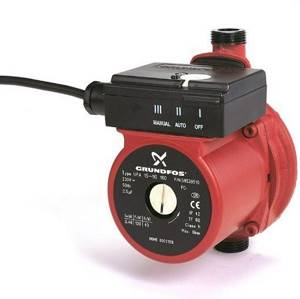
When installing a shut-off valve, remember that it must be easy to access so that in the event of an emergency the user can quickly turn it off.
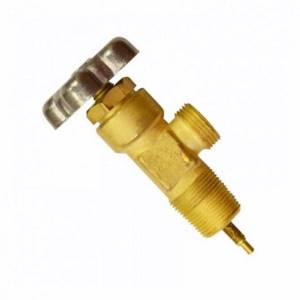
After completing the installation work, check the tightness of the connections and conduct a test run of the equipment.
Instructions. Conversion of the Neva 4511 gas water heater to liquefied gas
The gas column has jets with a diameter of 1.28 mm. This set of nozzles is installed in the burner ramp for operation on natural gas with a pressure of 130 mm. water Art. (130 mbar). The ramp at the Neva 4511 gas water heater is ten-sectional, i.e. The ramp includes 10 nozzles.
The set of liquefied gas nozzles we offer contains 10 nozzles with a diameter of 0.75 mm.
The offered kit is only suitable for this model,
because, for example, the Neva 4510 gas water heater has a ramp that is simply of a different design. Moreover, this model of Neva 4511 has been studied quite well by us. It is easy to install, repair and maintain. When converted to liquefied gas, the dispenser consumes about a kilogram of gas per hour of operation. Now you will see for yourself that altering the ramp will not take much time. To move the column we need a Phillips screwdriver and an adjustable wrench (38 mm). The column itself does not need to be dismantled at all.
Begin
First you need to separate the ramp. An ignition electrode (candle) and a flame presence (ionization) sensor are attached to the ramp. Separate them by unscrewing two screws.
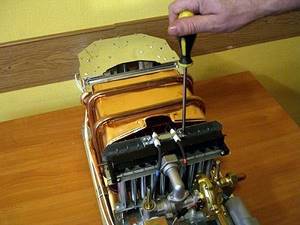
In the photo they are indicated by number No. 1. After separating the sensor and spark plug from the ramp, you need to remove four self-tapping screws (No. 2), which secure the burner ramp.
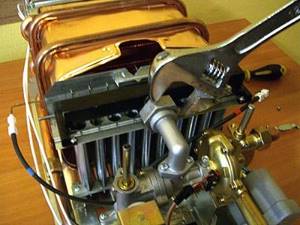
After separating them, take an adjustable wrench and unscrew the ramp nut from the gas column assembly.
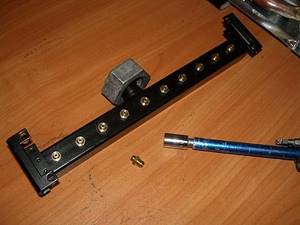
The ramp is in our hands. After the ramp is in our hands, it is best to turn out the jets with a 7 mm socket so as not to damage the splines when tightening the new nozzles with pliers or an open-end wrench (the wrench is the same as the 7 mm socket). As you can see, replacing the nozzles requires almost nothing from your brain.
Now we will understand the principle of operation of an instantaneous gas water heater using liquefied gas (also known as bottled gas). Let's see what advantages such boilers have and how to install them (install). Finally, let's look at the rating of manufacturers who produce the best models on the market.
You can find out the price and buy heating equipment and related products from us. Write, call and come to one of the stores in your city. Delivery throughout the Russian Federation and CIS countries.
Owners of private houses and summer cottages are constantly selecting the best option for supplying users with hot water. One such option is an instantaneous water heater operating on.
Instantaneous water heater Vektor JSD
Installation
Before installing a gas instantaneous water heater using liquefied gas, you need to understand the cylinder. It is important that it meets the following characteristics:
- There must be a gearbox on it.
- Pressure equal to 300 mm. water Art.
- The minimum capacity of the first phase of the cylinder should be 1 m³ per hour.
It is also necessary to purchase a flexible hose with an internal diameter of at least 12 mm and a length of no more than 2.5 m. This hose must withstand the gas, taking into account the required temperature and required pressure.
A gas shut-off valve must be installed in front of the column itself. After you complete the installation, be sure to check all connections and the hose so that if there are any problems, they can be corrected immediately.
If you have experience working with gas equipment, then you can install the gas water heater yourself. If not, you should contact a specialist.
Are there turbocharged models?
To heat water, you can use a turbocharged water heater. Such devices do not require a traditional vertical chimney; combustion products are discharged through a coaxial pipe led through the wall. It also supplies air to the closed firebox to maintain the combustion process. Turbocharged speakers have disadvantages: you need to make a hole in the pipe, ask the consent of neighbors above to install the equipment, the device is noisy due to the operation of the turbine. Plus, when working on propane-butane, you will also need to place a cylinder in the room. An important advantage of turbocharged versions is versatility; they can be placed in any room, since a chimney is not needed
The second important advantage is that they do not “eat up” the home air.
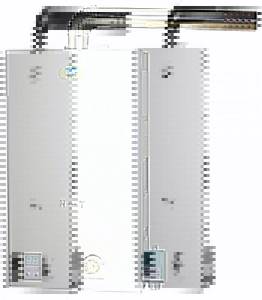
Gas consumption
The average user is interested in how much fuel his dispenser consumes. If the device operates from a centralized gas supply, you need to know how many cubic meters are consumed per unit of time; If it's propane, I wonder how long one tank will last? Costs depend on various characteristics and, above all, on thermal power. An example of calculating propane-butane consumption. Initial data:
- specific heat of combustion - 14 kW/h;
- Efficiency - about 92%;
- burning 1 kg of propane-butane mixture gives 12.9 kW/h.
Let us have a heater that produces 5 liters of hot water per minute, and fuel consumption is 1.5 kg per hour. A 50 liter cylinder contains 42 liters or 23 kg of propane-butane. By making simple mathematical calculations, you can find out that one cylinder is enough to heat 4,600 liters of water. Translated into hours, this is a little over 15 hours of continuous heating. If you use hot water for 2 hours a day, you will need 4 cylinders per month.

What volume of gas cylinder to choose
Based solely on current propane costs, it will be enough to install one 50 liter cylinder.
Even with uneconomical consumption of liquefied gas, the fuel should last for 10-15 days. And this is assuming a large family of 4-5 people. The technical data sheet for water heaters states that a 50 liter gas cylinder is enough for 10-12 hours of continuous operation. Experts recommend connecting a propane dispenser through a ramp. Thus, it is possible to reduce the load when operating a gas water heater from one to several gas cylinders, evenly distributing fuel consumption and preventing freezing of the walls and reducer. Connection via a ramp allows you to install several smaller containers of 25/40 liters each. Or, as an option, use 50 liter cylinders connected in conjunction with each other.
| Weight and internal volume of gas cylinders | ||||
| Volume (l) | ||||
| Empty cylinder weight (kg) | ||||
| Weight of propane cylinder (kg) | ||||
| Gas mass (kg) | ||||
| Cylinder height (mm) | ||||
| Cylinder diameter (mm) | ||||
| The volume of gas in the cylinder depending on the capacity | ||||
| Cylinder capacity (l) | ||||
| Gas capacity (m³) | ||||
| Liquid propane volume (l) | ||||
How to connect a column to a gas cylinder
During installation, the peculiarities of propane storage and combustion are taken into account. The dispenser will operate from bottled gas only when the supply pressure is reduced to 0.2-0.3 mBar and the nozzles are replaced. It is important to prevent the cylinders from freezing. To ensure the described conditions, the connection of a liquefied gas water heater is carried out in accordance with the following diagram:
- cylinders are connected via a ramp, several at a time, from 2-4 pcs.;
- To normalize the pressure, an adjustable reducer is installed.
If you connect a gas cylinder to a gas instantaneous or storage water heater according to the scheme described above, replace the jets on the wick and the nozzles on the main burner, adjust the fuel and water supply, you can achieve stable operation of the column after converting to propane.
How to choose
Instantaneous water heaters operating on gas - natural or liquefied - have almost the same design. Differences in nuances - materials, control method, degree of automation. Important parameters when choosing a gas water heater:
- Ignition method. Older versions were lit by hand using matches and lighters. Today, manufacturers offer three ignition options - piezo, electric and from a hydrogenerator.
- Heat exchanger material. The service life of the device depends on the quality of this part. If you buy a cheap Chinese device, the heat exchanger in it may turn out to be tin. Such water heaters do not last longer than three years.
- The inner diameter of the tubes in the heat exchanger. Wide tubes do not need to be descaled as often as narrow tubes.
- Water block. Metal is preferable. A cheaper alternative is plastic.
- Performance. When choosing this parameter, you need to take into account the volume of water flowing from the tap per unit time. The easiest way is to note the time and look at the result on the water meter. If the flow is less than 10 l/min, why buy a model with a capacity of 15 or more l/min?
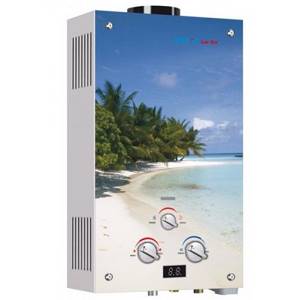
- Temperature control - manual or automatic. The first ones are cheaper. The adjustment is made by valves. In versions with power modulation, the temperature is maintained at a given level automatically.
- Removal of combustion products. It is safer to output through a coaxial chimney. Along with the power of the device, the diameter of the pipe increases. The second option is output through a traditional chimney. The third one has no chimney. The latter cannot be installed in a confined space and without ventilation. These are usually mini-speakers - devices with low power.
- Oxygen supply. In cheap versions, air is supplied through vents. Minus - combustion products penetrate back into the room. Expensive devices are equipped with a pipe leading from the bottom of the device. The housing is additionally closed with lids - from below and from above, so that combustion products do not penetrate into the room.
- Power. Mini-heaters of 17–19 kW are suitable for systems with low pressure and one water intake point. Powerful devices should be taken for a pressure of more than 10 l/min and with several water intake points. Versions for 21–31 kW are not installed in apartments, these are options for country houses.

Which model should you choose?
It all depends on the conditions of its use:
- Speaker power. How much domestic hot water do you plan to receive per minute (and room heating)?
- Is main gas connection available?
- How will you ignite the column: automatic, manual or mini-turbine?
- Dimensions of the room where the speaker will be located: a three-dimensional structure is unlikely to fit into small-sized apartments.
- Frequent changes in water supply pressure. Some models require a certain water pressure and turn off when the pressure is low.
Of course, you need to choose from the model range of a manufacturer that has proven itself with quality products (or rely on the recommendations of friends and family).
Switching to alternative fuel
Most dispensers can be converted to an alternative type of gas - from natural to liquefied and vice versa. The changeover must be carried out by a service department that has the appropriate certificate. You must use parts kits from the manufacturer. When reconfiguring, the manifold jets are replaced: you need to install nozzles with a diameter suitable for the type of fuel used and its pressure. When performing work, turn off the device and turn off the gas valve. After completion of work, check the tightness of the connections. On the device itself and in its instructions it is written what it is used for, the date of completion of the work, and the organization of the performer of the work.

Vector
"" - budget speakers assembled from Chinese components. Many consider them to be a thing of the past, but our consumers value them for their simplicity and low cost - the model range consists of devices whose price does not exceed 4,000 rubles.
Despite its cheapness, this equipment works properly, providing homes and apartments with hot water. All models have a stylish design; they can even become a decorative element. A distinctive feature is compactness. Chinese spare parts, if necessary, are easy to find in any market.
Controls - knobs for adjusting the gas and water passing through the heat exchanger. Some versions are equipped with a mode switch - winter and summer. The disadvantage is accelerated wear of spare parts. For example, the walls of the heat exchanger are made of copper, but this layer is so thin that they fade over time. There is no flame control module.
Vector JSD 20
Like all representatives of the Vector model range, the speaker is cheap - it costs about 4,000 rubles. Compact, fits in the cramped kitchen. There is a digital display and auto ignition. Color - white, gold and silver. Closed chamber. Electric ignition.

Vektor JSD 11-N
Compact version for small spaces. There is an automatic fire extinguishing sensor and overheating protection. Heats up 5 l/min. It weighs only 4.5 kg, but is designed for only one water intake point. Options:
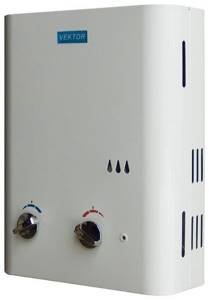
Vektor Lux Eco 20-3
This new product from Vector has improved protection that reduces the risk of overheating. The closed firebox is cooled with water. Selecting and setting the temperature mode. There is a digital display. Case with mirror panel. The model was developed taking into account changes in pressure in water pipes. The average cost is 8,000 rubles.
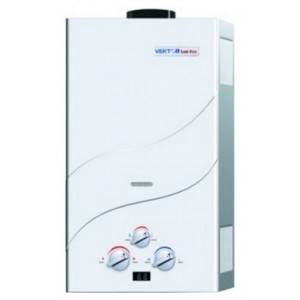
Now we will understand the principle of operation of an instantaneous gas water heater using liquefied gas (also known as bottled gas). Let's see what advantages such boilers have and how to install them (install). Finally, let's look at the rating of manufacturers who produce the best models on the market.
You can find out the price and buy heating equipment and related products from us. Write, call and come to one of the stores in your city. Delivery throughout the Russian Federation and CIS countries.
Owners of private houses and summer cottages are constantly selecting the best option for supplying users with hot water. One such option is an instantaneous water heater operating on.
Instantaneous water heater Vektor JSD
Principle of operation
The main function of geysers is to heat water in the shortest possible time. It looks like a housing in which the combustion chamber is located.
In a column powered by liquefied gas, water is heated as it flows through a heat exchanger, which in turn is heated by the burner. In addition, the device contains such elements as: a water cooling system, a control unit, temperature, pressure and draft sensors. Thanks to the electronic security system, the operation of the column is monitored throughout its entire operation.
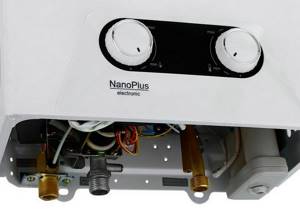
Water heater Electrolux GWH 265 ERN NanoPlus
Floor-standing
With an internal tank volume of 200 liters or more, the device is floor-mounted, since the load on the wall may be excessive. Gas floor-mounted storage water heaters are located in a special technical room, operate fully automatically and do not require frequent maintenance. Built-in safety systems protect equipment from overheating, loss of traction and other unpleasant situations.
It is worth noting. That gas equipment always carries danger, so when choosing, you should pay attention to recognized manufacturers. Products from brands such as BAXI, Bradford White and, of course, the founder of gas equipment for hot water supply, the German company VAILLANT, will be the best and most reliable choice.
A short overview video about Bradford White water heaters:
Geysers powered by gas cylinders
If there is no centralized gas supply, you have to heat water and cook food using gas water heaters and stoves that can run on a gas cylinder.
The gas cylinder used to heat water contains gases such as propane and butane. They are by-products of oil, gasoline and gas refining. The cylinders may contain only technical butane or a mixture of butane and propane, which is available in summer and winter.
Compression of these gases converts them into a liquid of a smaller volume (and therefore such a gas is called liquefied), and as the pressure decreases, this liquid begins to turn into a vapor state. Since an increase in temperature causes a strong expansion of liquefied gases, the cylinder is usually filled to 85% of its volume, so there is always a layer of vapor gas above the liquid gases.

For a dacha, choosing a heater that uses gas from a cylinder as an energy source is often the only way to get hot water in a dacha. In situations where there is no main gas pipeline connected to the dacha, and there are also problems with the electrical network, a gas water heater of this type will be a real salvation.

When operating a water heater connected to a gas cylinder, on average one gas cylinder with a capacity of 50 liters is enough to provide the minimum daily hot water for two to three people for a month.
First of all, you need to make sure that your gas water heater is configured to use the gas that is present in the cylinder. If required, work is carried out to re-adjust the column by replacing the collector nozzles and assessing the tightness of the connections. In this case, the equipment must be marked with the date of reconfiguration and the type of gas that can be used in the device.
The cylinder that will be connected to the gas water heater must be equipped with a reducer with a stabilization pressure of 300 mm water column, as well as a minimum vapor phase capacity of 1 m³ per hour
They also pay attention to the selection of the hose - its length should be up to two and a half meters, and the internal diameter should be from 12 millimeters
It is important to purchase a hose that can withstand working with a gas cylinder dispenser.

When installing the hose, do not bend or twist it. If the hose has to be installed with a bend, adapters are used for this and the radius of the bend is monitored (it should not be less than 90 mm along its outer line). In addition, the hose must not bend within 50 mm of the ends of the nozzles.
The installation of a gas shut-off valve must be carried out in front of the column so that this valve can be easily reached. After completion of installation work, the hose and other connections should be checked to ensure that leaks are detected in a timely manner. Only after this can the column be used to heat water.

www.o-vannoy.ru
Installation and installation of a liquefied gas water heater.
You can install a geyser yourself if you have some experience working with gas equipment. Liquefied gas cylinders (from 2 to 10) are connected in parallel, and each cylinder must have its own reducer.
If you lack experience, it is better to entrust the installation of gas equipment to specialists.
IT IS IMPORTANT TO REMEMBER that failure to comply with safety regulations when installing equipment can lead to an emergency.
Select:
Gas water heaters are very common even in big cities. In Soviet times, the quality of these products caused serious criticism. Extremely low safety systems and gas pressure requirements made the use of the devices very uncomfortable. The products did not have sufficient gas and hydraulic control systems, and flow control was not uniform. Modern speakers are practically devoid of these shortcomings and therefore most owners replace outdated devices.
If, due to their compact size, they are most often used in city apartments, then gas boilers are more preferable in country houses. A storage gas water heater is a container with heated sanitary water stored in it.
Unlike flow-type heaters, boilers do not have a very powerful burner and heat up over a longer period of time. This provides a number of serious advantages, the main one being the possibility of a large one-time consumption of hot water. For example, if in your house there are two or more shower rooms, the use of a column will not be able to provide them with DHW.
The volume of the purchased gas boiler must be calculated based on the expected peak consumption of hot water. For short-term use of two showers at the same time, the minimum volume will be a tank of 100 liters, however, the difference in cost with a larger product may not be significant and therefore you should not skimp on your own comfort.
The disadvantages of gas water heaters include the need to install a separate chimney and provide the room with a sufficient flow of fresh air. It is unacceptable to place gas heaters with an open combustion chamber in living rooms!
